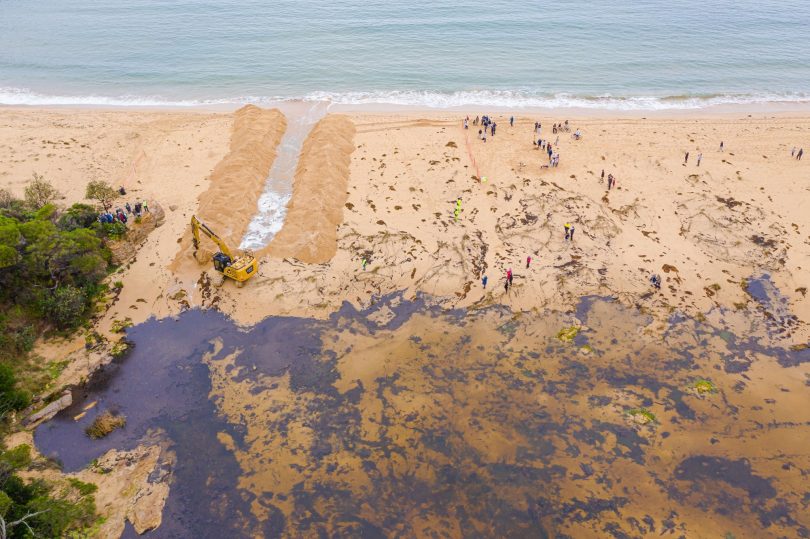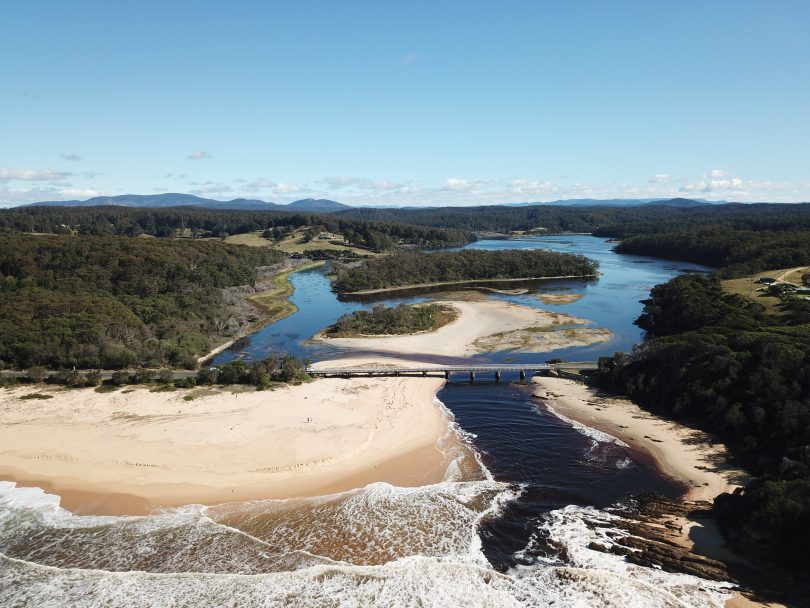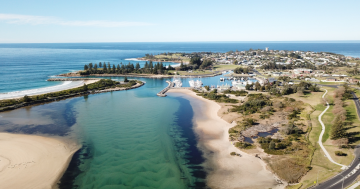
Drone footage of Lake Curalo in Eden being opened in late July. Photo: Phil Small Photography.
The opening of lakes and estuaries to the sea is often a local spectacle after heavy rain, with many people keen to see the flushing action revive waterways.
According to Bega Valley resident and Yuin man Graeme Moore, this same activity has been undertaken by Indigenous people for thousands of years, likely using sticks and scooping tools – and he’d like to see it done in the traditional way again.
“I picture a cultural revival. It’s not just this physical thing, the opening of the lake, but the social and cultural value of doing it together and the teaching and learning opportunities that come from that,” he says.
As recognition of Aboriginal land management increases, such as education about the benefits of cultural burning practices in controlling bushfires, Graeme would like to see knowledge and acceptance of Indigenous land management extended to include the management of waterways.
Bega Valley Shire Council currently manages the seven intermittently closed and open lakes and lagoons in the shire, opening them to the sea when they reach a certain level, which is unique to each waterway.
According to Council’s Environmental Coordinator Derek Van Bracht, the Entrance Opening Policies are reviewed every five years.
“The next review will begin in 2021 and we can take the opportunity to discuss an enhanced level of input from the Indigenous community on our current approach to entrance management,” he says.
Graeme sees the possibility of Indigenous-led waterway opening as something everyone can take part in.
“I think it’s important to involve as many people as possible, doesn’t matter the colour of your skin. We’d like to have partnerships with government agencies at a federal, state and local level to make this happen,” he says.
The council seeks to find a balance between letting the waterways open naturally and controlling for flood damage upstream, as recommended by NSW Fisheries.
At times, Mr Van Bracht explains, the opening is done because public or private infrastructure is under threat from flooding and in these cases, doing the job as quickly as possible becomes important.
“The policies also consider the potential need to open estuaries should there be significant water quality issues or environmental health concerns,” he says.
Mr Van Bracht says that when opening lake entrances, the council must consider state legislation, the risk to private property and community assets, the safety of the community, the environmental impact on the estuary and, most importantly, the safety of staff and the contractors and community members present.
“Some openings are dangerous, with big waves threatening the machinery and staff particularly during coastal storm events similar to the conditions we have experienced on the Far South Coast over recent weeks,” Mr Van Bracht says.

Cuttagee Entrance opened naturally after recent rains. Rachel Duczynski.
But, at other times, when the water level is high enough and there is no wild weather or floodwaters moving into the estuary, Mr Van Bracht says opening waterways is a relatively safe undertaking.
“Regardless of the conditions, the council is required to establish public exclusion areas around the worksite to ensure the safety of the public whilst the machinery is operating and whilst the initial release of waters is occurring,” he explains.
Mr Van Bracht says that the council has worked with the local Indigenous community at Wallaga Lake to ensure that waterway openings do not interfere with cultural sites.
Many estuaries are sacred sites for Indigenous people and burials often take place on headlands, Graeme says.
“Many of these places are women places and traditionally we are buried near where we are born so they are places of birth and death.
“I’ve had plenty of dialogue with the Campbell boys down at Wallaga Lake and they are very keen to get down there with shovels and open according to the signs we’ve been taught.
“We have our own ecology, so we look at when and why certain fish are in the lake, we look at the plants and the mud to know when it needs to be opened.”
Graeme doesn’t discredit the environmental science which guides the council but rather sees the two working together.
“It’s your science and our science working together,” he says.
For more information about how intermittently open lakes and lagoons are managed in NSW, visit The Department of Primary Industries.
To learn more about Bega Valley Shire’s entrance management policies visit the council’s website.







